Wadi Rum is a spectacularly scenic desert valley (wadi in Arabic) in southern Jordan. It is also known as "Valley of the Moon" and inscribed on the UNESCO World Heritage List.
This area of Jordan is quite isolated and largely inhospitable to settled life. The only permanent inhabitants are several thousand Bedouin nomads and villagers. There is no real infrastructure, leaving the area quite unspoilt. Apart from the Bedouin goat hair tents, the only structures are a few concrete shops and houses and the fort headquarters of the Desert Patrol Corps.
Wadi Rum is less a sandy desert but more a mountain desert. Very good pictures can also be made from the area north of the Turkish rail track parallel to the road from the Aqaba highway to Wadi Rum. The best time to visit Wadi Rum is when it is a little clouded, so you can experience the beautiful game of light and shadow in the desert.
T E Lawrence (of Arabia) spent a significant amount of time here during the course of the British-inspired Arab Revolt against the Ottoman Empire during the First World War (1914-1918). Fans of the 1962 film Lawrence of Arabia will be familiar with the landscape, which is not so much sand dunes as it is a mass of soaring cliffs and sandstone and granite mountains (jebel in Arabic).
Wadi Rum has also been used for more recent films, such as 2009's Transformers 2: Revenge of the Fallen, where it stood in for part of Egypt. The distinctive reddish-orange sands that lend the area an otherworldly quality has brought the science-fiction films The Last Days on Mars and The Martian here to replicate the Red Planet on Earth. The BBC documentary The Face follows two British climbers who pioneered routes in the canyons.
Also see the official site.
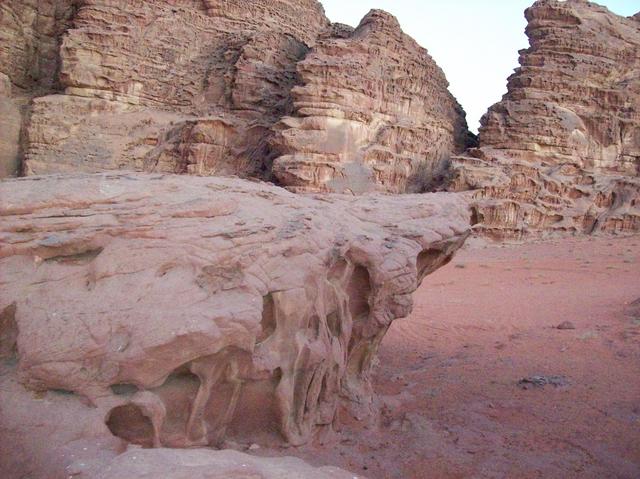
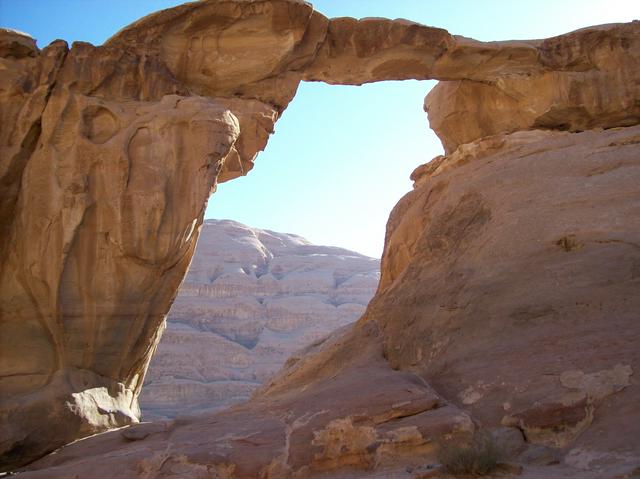
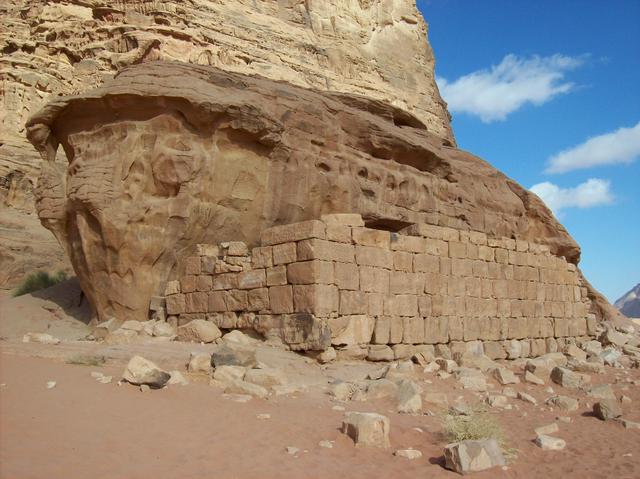
- Lawrence's house. Nobody is certain that this was Lawrence's house, although there are stories that he both stayed and/or stored weapons here. The current structure is built upon the remains of a Nabataean building, however, and it's another beautiful spot in the desert. The house itself is bunch of rubble, though, and not very impressive.
- Lawrence's Spring. 2 km south-west of the village of Rum. The spring is at the top of a short scramble - head for the fig tree! Although the pool itself is largely unprepossessing, being a stagnant puddle, the views across the desert are truly spectacular.
- Nabataean Temple. Near the Rest House in Rum Village. The surrounding area is covered in Thamudic and Kufic rock art.
- The Anfashieh Inscriptions: Not far from the red Sand Dune area this mountain has depictions of a camel caravan from the Nabatean and Thaumadic period.
- Burdah Rock Bridge.
- Umm Fruth Rock Bridge. A lower rock bridge which is featured on many tours and can be easily scrambled onto.
- Red Sand Dunes. There are various places in Wadi Rum where the white and red sands meet, but the most commonly visited is a dune sloping up alongside a jebel - a bit tough to climb up, great fun to run down! It can be difficult ascending those - use small steps.
- Seven Pillars of Wisdom. Although most people can only count five, this is an impressive rock formation near the Visitor's centre. It is named after T E Lawrence's book - not the other way around!
- Jebel Khaz'ali. This narrow canyon contains numerous Nabataean rock carvings of people and animals. Beautiful.
Lawrence's house. Nobody is certain that this was Lawrence's house, although there are stories that he both stayed and/or stored weapons here. The current structure is built upon the remains of a Nabataean building, however, and it's another beautiful spot in the desert. The house itself is bunch of rubble, though, and not very impressive.
Lawrence's Spring. 2 km south-west of the village of Rum. The spring is at the top of a short scramble - head for the fig tree! Although the pool itself is largely unprepossessing, being a stagnant puddle, the views across the desert are truly spectacular.
Nabataean Temple. Near the Rest House in Rum Village. The surrounding area is covered in Thamudic and Kufic rock art.
The Anfashieh Inscriptions: Not far from the red Sand Dune area this mountain has depictions of a camel caravan from the Nabatean and Thaumadic period.
Burdah Rock Bridge.
Umm Fruth Rock Bridge. A lower rock bridge which is featured on many tours and can be easily scrambled onto.
Red Sand Dunes. There are various places in Wadi Rum where the white and red sands meet, but the most commonly visited is a dune sloping up alongside a jebel - a bit tough to climb up, great fun to run down! It can be difficult ascending those - use small steps.
Seven Pillars of Wisdom. Although most people can only count five, this is an impressive rock formation near the Visitor's centre. It is named after T E Lawrence's book - not the other way around!
Jebel Khaz'ali. This narrow canyon contains numerous Nabataean rock carvings of people and animals. Beautiful.
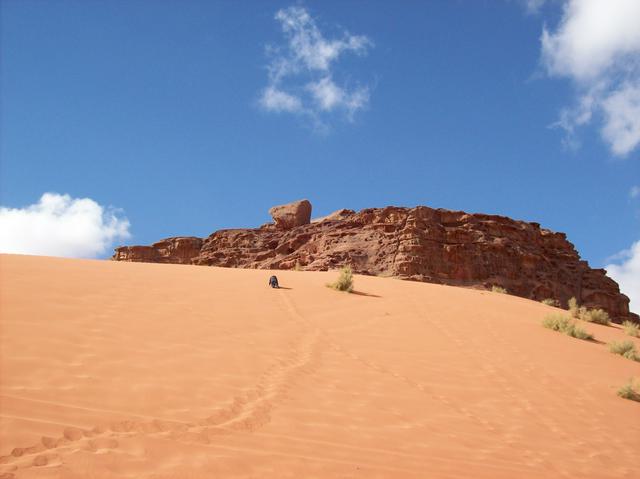 The genuine attraction of Wadi Rum is the desert itself, best seen by 4x4, on camel or foot. Some visitors only spend a few hours in the Wadi, but it's definitely worth staying overnight in Bedouin camps in the desert and taking a guided trip.
The genuine attraction of Wadi Rum is the desert itself, best seen by 4x4, on camel or foot. Some visitors only spend a few hours in the Wadi, but it's definitely worth staying overnight in Bedouin camps in the desert and taking a guided trip.
The quality 4-wheel-drive tour depends on Bedouin driver who serves as a guide, but often do not have much knowledge and poor English. Therefore picking up a guide at the gate is a hit and miss affair and many of the best guides rely mainly on advance bookings. Many of the guides have websites, through which you can arrange your tour.
Hiking is possible, especially in colder low season. Climbing is another popular activity and a number of guides are also trained climbers. Scrambling the ancient Bedouin Routes to the summits is another great option. Not quite climbing, but more rewarding than a simple hike and can often be combined with climbing or abseiling and/or camping on top of a peak.
The Distant Heat Festival is held every summer on the last Thursday of July which features trance and electronic music.
Hot Air Ballooning is also possible for 100-150 JD. Various companies are available, search the Internet or try this one.
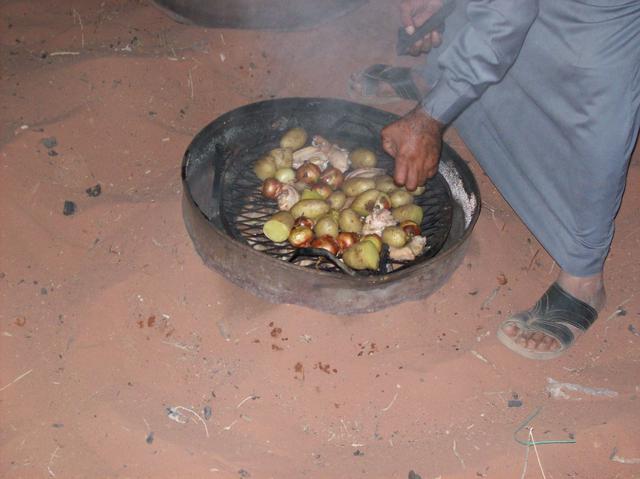
- At the entrance to the park, a small tent-restaurant serves simple Jordanian fare of bread, yogurt and such. There has been one report of food poisoning here, however.
- When you arrive at the Village there are a couple of shops where you can buy water and other soft drinks. Note that almost all the fruit juices are actually labelled as "fruit drinks", with sugar as the main ingredient. You might be able to find some pure fruit juice, such as Tropicana, if you look closely.
- Many camps will provide traditional Bedouin meals. One speciality is chicken or goat cooked under the desert sand, generically known as "zarb" in the same way as we might say "a roast". This has a barbecue flavour, but is very moist and falls off of the bone: try to be nearby when they unearth it as the smell released is gorgeous!
- You won't be able to avoid the Bedouin tea, which is almost forcibly served in every tent you will visit. It's hot, very sweet and usually flavoured with mint and/or sage. It's surprisingly refreshing on a hot day and you may develop a slight addiction to it.
As with many places, be cautious with anyone who seems interested in romantic entanglements, as incidents of foreign women being charmed by locals and then discovering that the "romance" was merely a cover to obtain sex, money, or other services are not uncommon and increasing. This seems especially true for young foreign travellers. The cosy camp surroundings and maybe some wine does the rest.
Just as for getting in, the route out of Wadi Rum involves joining the Desert Highway that runs between Amman and Aqaba. Petra is two hours north, and Aqaba is half an hour south, and these are the most common destinations to travel on to after leaving Wadi Rum.
There are public minibuses that run every day at least to Petra and Amman, but these are pretty expensive (20 JD to Amman). Minibuses run mostly in the morning, ask at your camp to have a place booked. There are also numerous taxis waiting for tourists at the parking lot in the Wadi Rum village. Hitchhiking is the cheapest and often the fastest option to get somewhere else. A good way to hitchhike is to ask other tourists at your camp or at the parking lot to give you a ride in their rented car - you will probably find someone who is going to Petra or Aqaba.
There is a daily minibus from Wadi Rum Village to Aqaba that leaves at 06:30, arriving about 07:30, costing 3 JD.
A private taxi to Aqaba will cost you 15-25 JD depending on where you are heading in the city. Taxis to the Israeli border will probably cost JOD20-25.
There is also a daily minibus from the Wadi Rum Visitors Centre to Wadi Musa (Petra) that departs at 08:30, takes around 2 hours, and costs 7.5-10 JD (Oct 2018) per person. Confirm the price with the driver in advance - including luggage which shouldn't cost extra - to avoid any nasty surprises.
Taxis to and from Petra cost roughly 30-35 JD.
There is a tourist minibus going from/to Amman everyday for 20 JD as of December 2018. Ask personnel at your accommodation to book you a seat.
